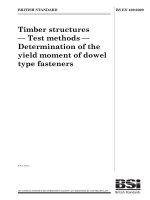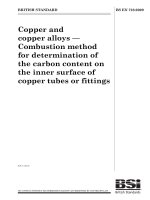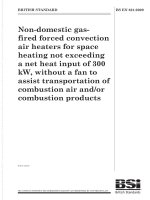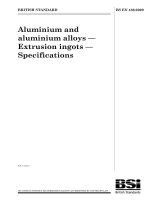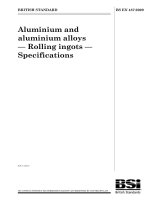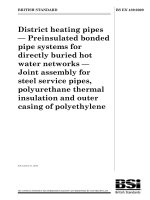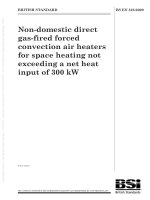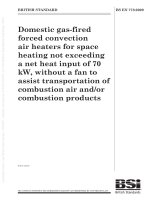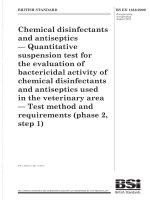Bsi bs en 00615 2009
Bạn đang xem bản rút gọn của tài liệu. Xem và tải ngay bản đầy đủ của tài liệu tại đây (411.1 KB, 36 trang )
BRITISH STANDARD
Fire protection — Fire
extinguishing media
— Specifications for
powders (other than
class D powders)
ICS 13.220.10,
NO COPYING WITHOUT BSI PERMISSION EXCEPT AS PERMITTED BY COPYRIGHT LAW
BS EN 615:2009
BS EN 615:2009
National foreword
This British Standard is the UK implementation of EN 615:2009. It
supersedes BS EN 615:1995 which is withdrawn.
The UK participation in its preparation was entrusted to Technical
Committee FSH/18/4, Powder media.
A list of organizations represented on this committee can be obtained on
request to its secretary.
This publication does not purport to include all the necessary provisions
of a contract. Users are responsible for its correct application.
Compliance with a British Standard cannot confer immunity
from legal obligations.
This British Standard
was published under the
authority of the Standards
Policy and Strategy
Committee on 31 July 2009
Amendments/corrigenda issued since publication
Date
Comments
© BSI 2009
ISBN 978 0 580 63794 0
标准分享网 www.bzfxw.com 免费下载
BS EN 615:2009
EUROPEAN STANDARD
EN 615
NORME EUROPÉENNE
EUROPÄISCHE NORM
April 2009
ICS 13.220.10
Supersedes EN 615:1994
English Version
Fire protection - Fire extinguishing media - Specifications for
powders (other than class D powders)
Protection contre l'incendie - Agent extincteurs Prescriptions pour les poudres (autres que les poudres
pour classe D)
Brandschutz - Löschmittel - Anforderungen an Löschpulver
(nicht für Löschpulver der Brandklasse D)
This European Standard was approved by CEN on 12 March 2009.
CEN members are bound to comply with the CEN/CENELEC Internal Regulations which stipulate the conditions for giving this European
Standard the status of a national standard without any alteration. Up-to-date lists and bibliographical references concerning such national
standards may be obtained on application to the CEN Management Centre or to any CEN member.
This European Standard exists in three official versions (English, French, German). A version in any other language made by translation
under the responsibility of a CEN member into its own language and notified to the CEN Management Centre has the same status as the
official versions.
www.bzfxw.com
CEN members are the national standards bodies of Austria, Belgium, Bulgaria, Cyprus, Czech Republic, Denmark, Estonia, Finland,
France, Germany, Greece, Hungary, Iceland, Ireland, Italy, Latvia, Lithuania, Luxembourg, Malta, Netherlands, Norway, Poland, Portugal,
Romania, Slovakia, Slovenia, Spain, Sweden, Switzerland and United Kingdom.
EUROPEAN COMMITTEE FOR STANDARDIZATION
COMITÉ EUROPÉEN DE NORMALISATION
EUROPÄISCHES KOMITEE FÜR NORMUNG
Management Centre: Avenue Marnix 17, B-1000 Brussels
© 2009 CEN
All rights of exploitation in any form and by any means reserved
worldwide for CEN national Members.
Ref. No. EN 615:2009: E
BS EN 615:2009
EN 615:2009 (E)
Contents
Page
Foreword ..............................................................................................................................................................4
1
Scope ......................................................................................................................................................5
2
Normative references ............................................................................................................................5
3
Definitions ..............................................................................................................................................5
4
Sampling .................................................................................................................................................6
5
Bulk density............................................................................................................................................6
6
Sieve analysis ........................................................................................................................................6
7
Chemical content ...................................................................................................................................6
8
8.1
8.2
8.3
8.4
Fire test performance ............................................................................................................................7
General ....................................................................................................................................................7
Class A powders ....................................................................................................................................7
Class B powders ....................................................................................................................................7
Class C powders ....................................................................................................................................7
9
Residual mass after discharge .............................................................................................................8
10
Resistance to caking and lumping.......................................................................................................8
11
Water repellency ....................................................................................................................................8
12
Moisture content ....................................................................................................................................8
13
Marking and packaging .........................................................................................................................8
14
Supplier's data sheet .............................................................................................................................9
www.bzfxw.com
Annex A (normative) Test method for determination of bulk density ........................................................ 10
A.1
Apparatus ............................................................................................................................................ 10
A.2
Procedure ............................................................................................................................................ 10
Annex B (normative) Test methods for sieve analysis ................................................................................ 11
B.1
Method 1 .............................................................................................................................................. 11
B.2
Method 2 .............................................................................................................................................. 11
Annex C (normative) Test method for resistance to caking and lumping ................................................. 13
C.1
Apparatus ............................................................................................................................................ 13
C.2
Procedure ............................................................................................................................................ 13
Annex D (normative) Test method for water repellency .............................................................................. 14
D.1
Apparatus ............................................................................................................................................ 14
D.2
Procedure ............................................................................................................................................ 14
Annex E (normative) Test method for moisture content.............................................................................. 15
E.1
Apparatus ............................................................................................................................................ 15
E.2
Procedure ............................................................................................................................................ 15
Annex F (informative) Suggested method of sampling ................................................................................ 16
Annex G (informative) Laser diffraction particle size analysis .................................................................... 17
Annex H (informative) Compatibility between extinguishing powders and foams ................................... 18
Annex I (informative) Suitability and equivalence of extinguishing powders in equipment .................... 19
Annex J (informative) Suggested test method for effective discharge time .............................................. 20
2
标准分享网 www.bzfxw.com 免费下载
BS EN 615:2009
EN 615:2009 (E)
J.1
J.2
J.3
J.4
Principle................................................................................................................................................ 20
Apparatus ............................................................................................................................................. 20
Procedure ............................................................................................................................................. 20
Expression of results .......................................................................................................................... 20
Annex K (informative) Suggested test method for testing the compatibility of powder with foam ......... 21
K.1
General ................................................................................................................................................. 21
K.2
Apparatus ............................................................................................................................................. 21
K.3
Test procedure ..................................................................................................................................... 22
Bibliography ...................................................................................................................................................... 32
www.bzfxw.com
3
BS EN 615:2009
EN 615:2009 (E)
Foreword
This document (EN 615:2009) has been prepared by Technical Committee CEN/TC 191 “Fixed firefighting
systems”, the secretariat of which is held by BSI.
This European Standard shall be given the status of a national standard, either by publication of an identical
text or by endorsement, at the latest by October 2009, and conflicting national standards shall be withdrawn at
the latest by October 2009.
Attention is drawn to the possibility that some of the elements of this document may be the subject of patent
rights. CEN [and/or CENELEC] shall not be held responsible for identifying any or all such patent rights.
This document supersedes EN 615:1994.
According to the CEN/CENELEC Internal Regulations, the national standards organizations of the following
countries are bound to implement this European Standard: Austria, Belgium, Bulgaria, Cyprus, Czech
Republic, Denmark, Estonia, Finland, France, Germany, Greece, Hungary, Iceland, Ireland, Italy, Latvia,
Lithuania, Luxembourg, Malta, Netherlands, Norway, Poland, Portugal, Romania, Slovakia, Slovenia, Spain,
Sweden, Switzerland and the United Kingdom.
www.bzfxw.com
4
标准分享网 www.bzfxw.com 免费下载
BS EN 615:2009
EN 615:2009 (E)
1
Scope
This European Standard is applicable to fire extinguishing powders for fire classes A, B and C. It specifies, by
means of defined test methods, minimum requirements for the chemical and physical properties and minimum
extinguishing capabilities. Requirements are also specified for the information and data to be given by the
supplier.
This European Standard is not applicable to powders for class D fires.
NOTE 1
The classification of fires is given in EN 2 [1].
NOTE 2
Some countries have national standards for class D powders.
2
Normative references
The following referenced documents are indispensable for the application of this document. For dated
references, only the edition cited applies. For undated references, the latest edition of the referenced
document (including any amendments) applies.
EN 3 (all parts), Portable fire extinguishers
EN ISO 4788, Laboratory glassware - Graduated measuring cylinders (ISO 4788:2005)
ISO 3310-1, Test sieves - Technical requirements and testing - Part 1: Test sieves of metal wire cloth
3
www.bzfxw.com
Definitions
3.1
(extinguishing) powder
extinguishing medium composed of finely divided solid chemical products consisting of one or more principal
components which are combined with additives to improve its characteristics
NOTE 1
In North America and some other countries, the term "dry powder" is used to denote special metal fire
extinguishing agents and the term "dry chemical extinguishing agent" is used to denote the extinguishing medium
specified in the European Standard.
NOTE 2
When it is useful to indicate the class of fire for which a powder is designed, capital letters may be added
before the term. The letters used in this European Standard are those defined in EN 2 [1].
EXAMPLE BC powder is designed to extinguish class B (liquids or liquefiable solids) and class C (gases) fires; ABC
powder is designed to extinguish class A (solids which form glowing embers), class B and class C fires.
3.2
batch
single charge of powder in the processing equipment that has been made homogeneous by subjection to the
same unit and physical processing
3.3
lot
one or more batches, but not more than 25 t of powder, manufactured to the same formulation by the same
manufacturing process and under the same environmental conditions
NOTE
Any substantial change in manufacturing process, source of raw materials, or change in environmental
conditions may justify identifying the material as a different lot.
5
BS EN 615:2009
EN 615:2009 (E)
3.4
characteristic value
value declared by the supplier for the chemical and physical properties of the powder
3.5
supplier
party e.g. manufacturer, distributor, importer, responsible for the powder and able to ensure that quality
assurance is exercised
4
Sampling
4.1 Samples for testing shall be taken using a method which will provide a representative sample. In order to
avoid any risk of condensation, it is essential that the temperature of the powder in its original container is not
lower than the ambient air temperature when the sample is being taken.
4.2 Samples shall be stored in individual, clean, dry, airtight, non-reactive and suitably identified containers.
4.3 Sample containers should not be opened until temperature equilibrium with the laboratory has been
reached.
NOTE 1
One suitable method of sampling is suggested in Annex F.
NOTE 2
Unless otherwise specified, all tests on samples are carried out at (20 ± 5) ºC.
5
Bulk density
www.bzfxw.com
The bulk density shall be within ± 0,07 g/ml of the characteristic value when tested in accordance with Annex
A.
6
Sieve analysis
The cumulative percentages oversize on the 40 µm sieve and on the 63 µm sieve shall not differ from the
characteristic values by more than ± 8 % of the total mass of the sample, and the cumulative percentage
oversize on the 125 µm sieve shall not differ from the characteristic value by more than ± 5 % of the total
mass of the sample when the powder is tested in accordance with one of the methods of Annex B.
NOTE 1
size.
Annex G describes one of the methods of analysis technique which gives more detailed information on particle
NOTE 2
The two methods described in Annex B may give differing results. The method used should therefore be given
in the results.
7
Chemical content
Characteristic values for chemical content shall be expressed as percentages (m/m) of the total content.
The characteristic values for chemical content shall include all constituents present in the powder at a
concentration representing 10 % or more of the total content. The sum of the characteristic values for
chemical content shall be 90 % or more of the total content.
Each constituent given a characteristic value shall be identified by its chemical name, or as the reaction
product of a chemical process between reactants identified by their chemical names. In the latter case, the
chemical process shall be specified, for example by reference to a published patent.
6
标准分享网 www.bzfxw.com 免费下载
BS EN 615:2009
EN 615:2009 (E)
The content of a declared constituent shall be as follows:
a)
within ± 1,0 % of the total chemical content for constituents of characteristic value more than 10 % but not
more than 15 %;
b)
within ± 1,5 % of the total chemical content for constituents of characteristic value more than 15 % but not
more than 25 %;
c)
within ± 2,0 % of the total chemical content for constituents of characteristic value more than 25 % but not
more than 65 %;
d)
within ± 3,0 % of the total chemical content for constituents of characteristic value more than 65 % and
above.
NOTE 1
For example, a constituent with a characteristic value of 20 % has tolerance limits of 18,5 % and 21,5 % and a
constituent with a characteristic value of 80 % has tolerance limits of 77 % and 83 %.
NOTE 2
WARNING It is important that under normal conditions of use the various materials and additives used to
produce powders be generally recognized as being non-toxic to humans. In some countries there may be a legal
obligation to disclose to designated authorities the complete chemical content, and any proposed changes of chemical
content, with documented details of non-toxicity.
NOTE 3
The compatibility of the powder with foam (see Annex H) depends on chemical content. The test described in
Annex K may allow a determination of foam/powder compatibility to be made.
NOTE 4
WARNING The mixing of different types of powder (ABC and BC) may result in caking, and the production of
gas which will increase pressure in the container to an unsafe level. Such increases in pressure have been known to
cause containers to rupture, and to cause bodily injury and damage.
www.bzfxw.com
NOTE 5
WARNING Recovered powder may have been previously contaminated, and may have absorbed moisture. If
it is then recycled, the powder may eventually become lumpy, and interrupt the flow of powder when used on a fire.
8
8.1
Fire test performance
General
A 6 kg or 9 kg stored pressure or cartridge extinguisher may be used to test conformity to this clause, but the
same model of extinguisher shall be used for class A rating (if applicable), class B rating and to test conformity
with Clause 9.
NOTE
Clauses 8.2 and 8.3 specify minimum performance requirements, Annex I gives information on the suitability
and equivalence of extinguishing powders in the equipment, and Annex J gives information on the importance of other
performance testing.
8.2
Class A powders
A powder claimed by the supplier to be suitable for class A fires when tested using either a 6 kg or 9 kg
extinguisher recommended by the supplier, shall conform to the fire performance requirements of EN 3.
8.3
Class B powders
A powder claimed by the supplier to be suitable for class B fires when tested using either a 6 kg or 9 kg
extinguisher recommended by the supplier, shall conform to the fire performance requirements of EN 3.
8.4
Class C powders
A powder claimed by the supplier to be suitable for class C fires shall conform to 8.3.
7
BS EN 615:2009
EN 615:2009 (E)
9
Residual mass after discharge
When tested in the 6 kg or 9 kg extinguisher model recommended by the powder supplier and used to test
conformity to Clause 8, the residual mass shall conform to the requirements of EN 3.
NOTE
Annex J describes a technique for conducting discharge performance tests which give more detailed
information than that necessary to establish conformity to EN 3.
10 Resistance to caking and lumping
Any lumps formed shall not be retained on the 425 µm sieve when the powder is tested in accordance with
Annex C.
11 Water repellency
There shall be no COMPLETE absorption of the water droplets when the powder is tested in accordance with
Annex D.
12 Moisture content
The moisture content shall not exceed 0,25 % (m/m) when determined in accordance with Annex E.
www.bzfxw.com
13 Marking and packaging
NOTE
Extinguishing powders should be packaged in containers which are essentially moisture resistant. The
supplier should ensure that every consignment is packed in such a way as to preserve its essential characteristics when
stored and handled in accordance with the supplier's recommendations.
Each separate package, or a label firmly attached to the package, shall be marked in a language required by
the purchaser with the following information:
a)
the commercial name of the product followed by the words "Fire extinguishing powder";
b)
the classes of fire for which the powder is claimed to be suitable;
c)
the year of manufacture, and the batch or lot number;
d)
any essential recommendations regarding conditions of storage;
e)
the name and address of the supplier;
f)
the warning statement "Ensure compatibility between this product and the equipment in use";
g)
the words "See supplier's data sheet for precautions in handling";
h)
the number and date of this European Standard, i.e. EN 615:2009 1.
1
Marking EN 615:2009 on or in relation to a product represents a supplier's declaration of conformity, i.e. a
claim by or on behalf of the supplier that the product meets the requirements of this standard. The accuracy of
the claim is therefore solely the responsibility of the person making the claim. Such a declaration is not to be
confused with third party certification of conformity, which may also be desirable.
8
标准分享网 www.bzfxw.com 免费下载
BS EN 615:2009
EN 615:2009 (E)
14 Supplier's data sheet
If requested by the purchaser, the supplier shall provide a data sheet giving precautions in handling, a
declaration of conformity with this European Standard, the characteristics value for bulk density and, with
descriptions of the test methods used, the characteristic values for sieve analysis and chemical content (see
Clauses 5, 6 and 7).
www.bzfxw.com
9
BS EN 615:2009
EN 615:2009 (E)
Annex A
(normative)
Test method for determination of bulk density
NOTE
See Clause 5.
A.1 Apparatus
Clean dry 250 ml stoppered glass measuring cylinder, conforming to EN ISO 4788, having an approximate
height of 320 mm and an approximate internal diameter of 40 mm.
A.2 Procedure
Place (100 ± 0,1) g of the powder in the cylinder. Secure the stopper in the cylinder. Rotate the cylinder end
over end for 10 complete revolutions, at approximately 1 revolution every 2 s. Immediately after the 10
revolutions have been completed, set the cylinder upright on a level surface and allow the powder to settle for
(180 ± 10) s. Read off the volume occupied by the powder. Calculate the bulk density, Qb from the equation:
Qb =
m
v
where
www.bzfxw.com
m
is the mass of the powder (in g);
v
is the volume occupied by the powder (in ml).
NOTE 1
Electrostatic phenomena may cause difficulty in testing powders containing stearates. The problem is reduced
by prior testing of a siliconized powder.
NOTE 2
After long-term storage the bulk density may increase.
10
标准分享网 www.bzfxw.com 免费下载
BS EN 615:2009
EN 615:2009 (E)
Annex B
(normative)
Test methods for sieve analysis
NOTE 1
See Clause 6.
NOTE 2
The two methods described in B.1 and B.2 may give differing results.
B.1 Method 1
B.1.1 Apparatus
B.1.1.1 Nest of sieves, having a nominal diameter of 200 mm and aperture sizes of 125 µm, 63 µm and 40
µm, conforming to ISO 3310-1, a lid and a collecting pan with the 125 µm sieve as the top sieve with the lid
placed on top and the 40 µm sieve as the bottom sieve with the collecting pan placed underneath.
B.1.1.2 Sieve-shaking device, capable of moving the nest in a horizontal ellipse with an impact from the
bottom to the top of the nest at every ninth pass.
B.1.2 Procedure
www.bzfxw.com
Accurately weigh to ± 0,02 g approximately, 20 g of the powder into the top sieve. Assemble on the shaking
device and shake for (10 ± 0,2) min. Weigh the quantity of powder retained on each sieve and in the collecting
pan. Check that the sum of all weights equals the initial weight of powder taken, to within ± 2 %; if not, repeat
the test. Calculate the cumulative weights retained on the 63 µm and 40 µm sieves, and report as cumulative
percentage oversize.
B.2 Method 2
B.2.1 Apparatus
B.2.1.1
Three sieves, as described in B.1.1.1.
B.2.1.2 Air-jet sieving device 2, which provides an air flow from above to below the sieve with a reverse airjet from a rotating arm beneath the sieve (see Figure B.1).
B.2.2 Procedure
Carry out three tests using the 125 µm, 63 µm and 40 µm sieves in turn.
Follow the air-jet sieving device manufacturer's instructions. Accurately weight to ± 0,02 g approximately 20 g
of powder and sieve for (5 ± 0,1) min. Report the percentage retained on each sieve as cumulative
percentage oversize.
2 A suitable apparatus, available commercially, is Model A200LS manufactured by Alpine AG, Peter-Dörfler-Strasse 13-
25, P.O. Box 101109, 8900 Augsburg, Germany. This information is given for the convenience of the users of this
European Standard and does not constitute an endorsement of this apparatus by CEN.
11
BS EN 615:2009
EN 615:2009 (E)
1
2
3
4
www.bzfxw.com
Key
1
2
3
4
Sieve
Rotating radial arm with slot
Air in
Air and fine particles out
Figure B.1 – Air-jet sieving device
12
标准分享网 www.bzfxw.com 免费下载
BS EN 615:2009
EN 615:2009 (E)
Annex C
(normative)
Test method for resistance to caking and lumping
NOTE
See Clause 10.
C.1 Apparatus
C.1.1 Petri dish, approximately 70 mm diameter.
C.1.2 Pallet knife.
C.1.3 Desiccator, with saturated sodium chloride solution giving approximately 75 % relative humidity.
C.1.4 Oven, controlled to (48 ± 3) °C.
C.1.5 425 µm sieve, conforming to ISO 3310-1.
C.2 Procedure
www.bzfxw.com
Place an excess of powder in the Petri dish and smooth the surface flush with the rim using the pallet knife.
Place the Petri dish in the desiccator at (20 ± 5) °C for (24 ± 1) h, then place the Petri dish in the oven for (24
± 1) h. Cover the Petri dish and allow to cool at (20 ± 5) °C for (60 ± 10) min, then remove the cover and
overturn the Petri dish on to a clean sheet of paper. Gently pour the powder into the sieve, and gently shake
the sieve to separate any lumps that may have formed.
Using a spatula to lift the lumps, drop them from a height of (200 ± 10) mm on to a hard surface. Carefully
collect the powder and place gently into the sieve. Gently shake as before for (20 ± 2) s and check to see
whether any lumps are retained.
13
BS EN 615:2009
EN 615:2009 (E)
Annex D
(normative)
Test method for water repellency
NOTE
See Clause 11.
D.1 Apparatus
Petri dish, pallet knife and desiccator as described in C.1.1, C.1.2 and C.1.3.
D.2 Procedure
Place an excess of powder in the Petri dish and smooth the surface flush with the rim using the pallet knife.
On three different areas of the powder surface, place a drop (approximately 0,3 ml) of distilled water. Place
the Petri dish in the desiccator for (120 ± 5) min at (20 ± 5) °C. Remove the Petri dish from the desiccator and
examine the drops. The drops shall not have been completely absorbed by the powder.
www.bzfxw.com
14
标准分享网 www.bzfxw.com 免费下载
BS EN 615:2009
EN 615:2009 (E)
Annex E
(normative)
Test method for moisture content
NOTE
See Clause 12.
E.1 Apparatus
E.1.1 Petri dish, as described in C.1.1.
E.1.2 Desiccator, with concentrated sulphuric acid.
E.2 Procedure
Accurately weigh to ± 0,001 g approximately 20 g of the powder into the Petri dish. Store the uncovered dish
for (48 ± 2) h at a temperature of (20 ± 3) °C in the desiccator. Reweigh and calculate weight loss. Report the
weight loss as a percentage of original sample weight.
www.bzfxw.com
15
BS EN 615:2009
EN 615:2009 (E)
Annex F
(informative)
Suggested method of sampling
When sampling a lot, not less than 12 kg of material should be taken at random from batches. For batch
testing, not less than 2,5 kg should be taken at random from a container.
For relatively small quantities, a 25 mm metal sampling tube should be inserted to the full depth of the
container at no fewer than five locations.
www.bzfxw.com
16
标准分享网 www.bzfxw.com 免费下载
BS EN 615:2009
EN 615:2009 (E)
Annex G
(informative)
Laser diffraction particle size analysis
In order to obtain more detailed information about the particle size distribution in the range 0 µm to 100 µm,
equipment other than that specified in Clause 6 should be used.
One instrument that can give such information is the laser diffraction particle size analyser.
Using the technique of laser diffraction particle size analysis, particles from approximately 0,5 µm to 500 µm
can be analysed. In principle, the equipment consists of a laser transmitter and receiver unit usually mounted
about 500 mm apart. The powder is sprayed with a dry powder feeder or in a saturated solution through the
laser beam. Particles passing through the laser beam scatter the light, which is focused on to a special
detector. Suitable electronic equipment detects the various outputs and digitizes them. They are then
converted into a particle size distribution by an integral computer.
www.bzfxw.com
17
BS EN 615:2009
EN 615:2009 (E)
Annex H
(informative)
Compatibility between extinguishing powders and foams
Under some circumstances, incompatibility between extinguishing powders and foams may exist. The user
should ensure that any combination of extinguishing powder and foam which may be used does not lead to an
unacceptable loss of efficiency caused by unfavourable interaction of the chosen media, when applied
simultaneously or successively.
The test described in Annex K may be useful in determining whether incompatibility between extinguishing
powder and foam may exist.
www.bzfxw.com
18
标准分享网 www.bzfxw.com 免费下载
